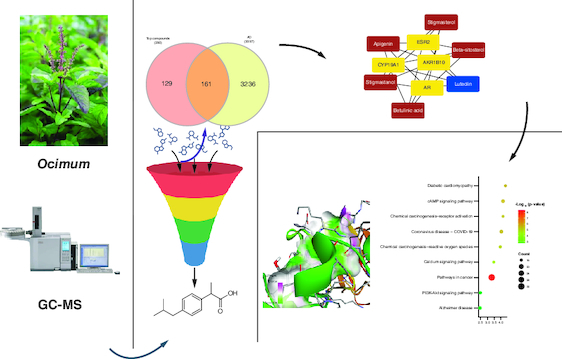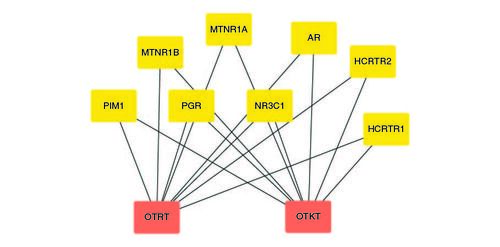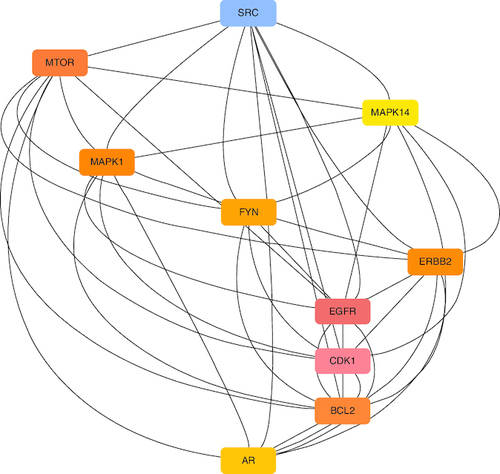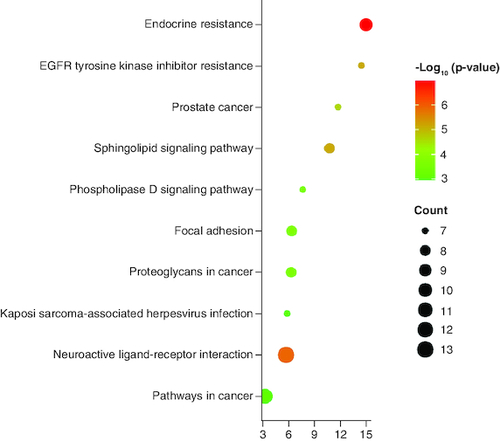Abstract
Aim: In this study, we have selected two different Ocimum tenuiflorum plants, Ocimum tenuiflorum (Rama tulsi) (OTRT) and Ocimum tenuiflorum (Krishna tulsi) (OTKT). Materials & methods: In the present investigation, ethanol was used as a solvent to estimate the bioactive compounds present in it through gas chromatography-mass spectrometry (GC–MS). Results: Based on the GC-MS data benzenepropanoic acid, 3-methoxy-alpha,4-bis[(trimethylsilyl)oxy was found to be the potent compound in OTRT (MW: 428.74 g/mol) and methyl 3-(4-benzyloxy-3,5-dimethoxyphenyl)-2-methylpropanoate in OTKT (MW: 342.39 g/mol). To estimate its pharmacological application, an integrated Network Pharmacology approach is performed toward the disease target obesity. Conclusion: From the protein–protein interaction from the string database, SRC, BCL2, EGFR, MTOR, CDK1, ERBB2, MAPK1, FYN, AR and MAPK14 are the top-ranked targets.
Graphical abstract

Ocimum tenuiflorum species, such as Tulsi or Holy Basil, are traditionally known for their potential medicinal properties.
They are reported to contain various bioactive compounds, including steroids, tannins, alkaloids, flavonoids and phenolics, and have demonstrated anti-hyperglycemic properties, making them valuable for diabetes management.
Network biology and network pharmacology were employed to explore potential targets for obesity management.
Samples of two Ocimum tenuiflorum species, Rama tulsi and Krishna tulsi, were collected, authenticated, and prepared for analysis.
The samples were subjected to GC-MS analysis to identify compounds of interest.
Two high molecular weight compounds, OTRT and OTKT, were selected for further study.
Network pharmacology was used to identify potential targets related to obesity for these compounds.
GC-MS analysis revealed various compounds, with OTRT and OTKT being selected due to their high molecular weight.
Network pharmacology identified key targets associated with obesity and potential interactions with the selected compounds.
The study highlighted the importance of kinase enzymes in various cellular processes related to obesity.
The KEGG pathway analysis provided insights into the potential mechanisms of action of the compounds.
The drug-likeness and pharmacokinetic profiles of OTRT and OTKT were assessed.
Molecular docking analysis indicated the binding affinity of these compounds to specific targets.
The study emphasized the potential toxicity and pharmacological properties of the compounds.
The study successfully identified bioactive compounds from Ocimum tenuiflorum species through GC-MS analysis.
Network pharmacology provided valuable insights into potential targets for obesity management.
The findings suggest that these compounds could serve as lead molecules in drug development for obesity and diabetes management.
Further preclinical and clinical investigations are needed to validate the potential therapeutic applications of these bioactive compounds.
Ocimum tenuiflorum species are herbal plants that are majorly available in the Asian region, which belongs to the Lamiaceae family. More than 100 species of Ocimum tenuiflorum have been reported so far, and the Ocimum tenuiflorum species have reported multiple pharmacological effects. Due to the presence of steroids, tannins, alkaloids, flavonoids and phenolics [Citation1]. Many regions, including Asia and Africa, plant O. tenuiflorum L., known as Tulsi or Holy basil. By boosting the insulin secretion from isolated islets, perfused pancreas and clonal pancreatic cells, the leaf extracts of O. tenuiflorum L. (formerly known as O. sanctum L.) have been demonstrated to exhibit anti-hyperglycemic properties. It is regarded as one of the most effective traditional plants for treating diabetes and comes highly recommended [Citation2]. Some studies suggest that extracts from certain Ocimum species, such as holy basil, may have the ability to lower blood sugar levels. They are believed to influence insulin secretion and sensitivity, potentially helping people with diabetes maintain better control over their blood glucose levels. O. tenuiflorum extracts reported to have anti-diabetic activity due to its ability to suppress endogenous glucose release, inhibit glycogenolysis and/or stimulate glycogenesis [Citation3,Citation4]. Many pre-clinical and in silico studies shows the possible therapeutic potential of O. tenuiflorum in the management of diabetes [Citation5]. Network biology and Network Pharmacology is an integrated approach which helps in the identification of druggable genomes [Citation6]. Various genes play a significant role in obesity and other cardiometabolic complications, either directly or indirectly, such as SRC. The SRC gene is involved in regulating adipocyte differentiation and energy expenditure, influencing obesity risk. MTOR is a central regulator of metabolism and adipogenesis, contributing to the development of obesity when dysregulated. EGFR signaling can affect appetite regulation and adipose tissue expansion, playing a role in obesity. The BCL2 gene influences apoptosis and adipocyte survival, impacting obesity-related adipose tissue changes. CDK1 contributes to cell cycle control and adipogenesis, affecting adipocyte development in obesity. ERBB2 signaling can influence adipocyte growth and energy balance, potentially contributing to obesity [Citation7-11]. MAPK1 participates in MAPK signaling pathways associated with inflammation and obesity-related complications. The FYN kinase is implicated in central leptin signaling, affecting appetite control and obesity development. The androgen receptor (AR) gene can impact fat distribution and body composition, influencing obesity risk. MAPK14 is involved in inflammatory pathways and can contribute to obesity-related inflammation and insulin resistance [Citation11,Citation12]. Therefore, in this paper, we aid to discuss the GC-Ms analysis of two different Ocimum tenuiflorum plants, Ocimum tenuiflorum (Rama tulsi) (OTRT) and Ocimum tenuiflorum (Krishna tulsi) (OTKT) and integrated network pharmacology approach toward obesity in the identification of top-ranked targets.
Method
Sample collection
The whole plants of two different varieties of Ocimum tenuiflorum species, Ocimum tenuiflorum (Rama tulsi) and Ocimum tenuiflorum (Krishna tulsi), were collected from Villupuram, Villupuram district, Tamil Nadu, India during the summer season. M. Sivaraman, PG and Research Department of Botany, Arignar Anna Government Arts College, Villupuram, Tamilnadu, India, verified the authenticity of the plants. The leaf, stem and root part of the two species were separated carefully, washed in running water and then kept for air drying at room temperature. The air-dried samples were powdered using an electric blender and stored in airtight containers with proper labeling.
Preparation of sample
Five g of powdered material from the whole plants of two Ocimum tenuiflorum species were carefully weighed using a precision scale. They subsequently underwent an extraction process involving 50 ml of ethanol within a 100 ml conical flask. The entire plant extracts were placed in a shaking orbital incubator for a duration of 72 h to ensure thorough extraction. To guarantee complete extraction, a re-extraction step was performed for each sample using ethanol until a colorless solvent was obtained. Following the completion of the extraction process, the resulting fraction was filtered using a Whatman no. 1 size filter and concentrated through the use of a rotary evaporator. The concentrated extracts were then air-dried in glass petriplates to facilitate the removal of residual ethanol via evaporation. In total, six air-dried extracted samples from the two Ocimum tenuiflorum species were collected, weighed and subsequently utilized for GC-MS analysis.
GC-MS analysis
The extracted samples from the whole part of the two Ocimum tenuiflorum species (Rama and Krishna tulsi) were subjected to GC-MS analysis using GC-MS QP 2010 by Shimadzu. The sample preparation for GC-MS analysis was enacted by the addition of 1 mg of the extract sample with 1 ml of ethanol as a solvent. The instruments was equipped with a split mode injector, through which the sample was injected into the Zebron ZB-FFAP column fused with silica, with the dimensions of 60 m × 0.25 mm and a film thickness of 0.25 μm for separations. Helium was used as a carrier gas, flowing at a rate of 1 ml/min. The sample was injected in a split mode at the rate of 1 μl/min with a split ratio of 1:50. The injection temperature was kept at 250 °C. The other conditions in operation of GC-MS includes ion source temperature, 200 °C; interface temperature, 280 °C; pressure, 53.5 kPa. The column oven temperature was kept at 50°C and maintained for 1 min, it was then increased gradually at 10 °C/min until it reached 280 °C, and was then held at this temperature for 2 min. The GC-MS scan spectra obtained at the range width of 40–700 m/z. Wiley 8 and NIST 14 libraries attached with the GC-MS instrument were used to identify the components by comparing their retention indices. The identified components based on the computer libraries (Wiley 8 and NIST 14) were tabulated. The GC-MS data of OTRT is given in and the GC-MS data of OTKT is given in . For the Network analysis the targets related to OTRT and OTKT were estimated from Swiss target Online database. The top-ranked targets related to OTRT and OTKT were given in .
Table 1. GC-MS analysis of Ocimum tenuiflorum (Rama tulsi).
Table 2. GC-MS analysis of Ocimum tenuiflorum (Krishna tulsi).
Results
The GC-MS analysis reported the presence of many compounds. Of those, only two compounds reported with a high molecular weight. The identified compounds are provided in . The selected compound from Rama tulsi was coded as OTRT–Benzenepropanoic acid, 3-methoxy-alpha,4-bis[(trimethylsilyl)oxy(C19H36O5SI3) (MW: 428.74 g/mol). The selected compound from Krishna tulsi was OTKT: Methyl 3-(4-benzyloxy-3,5-dimethoxyphenyl)-2-methylpropanoate (C20H22O5) (MW: 342.39 g/mol). The GC-MS data is given & . Based on the higher molecular weight justification these two compounds further taken in to network pharmacology. From the GC-MS data, major compounds have been securitized for network pharmacology. In this study, 01 compounds have selected for Ocimum tenuiflorum (Rama tulsi) (OTRT) based on the GC-MS data given in table 1 and 01 compounds were selected from Ocimum tenuiflorum (Krishna tulsi) (OTKT) based on the GC-MS data given in table 2. The list of selected compounds was given in . The drug-likeness profile and pharmacokinetic profile of OTRT and OTKT is given in . The top-ranked targets of selected compounds were illustrated in . The toxicity profile is given in . The obesity (Obesity, C0028754) disease-related targets were generated from the Disgenet database. The obesity-related targets and OTRT and OTKT were overlapped and overlapped genes were identified as hub-genes for protein–protein interaction (PPI). The overall target numbers are illustrated in . The PPI interaction was estimated from string online database the top-ranked targets were illustrated in hierarchy model in . SRC, BCL2, EGFR, MTOR, CDK1, ERBB2, MAPK1, FYN, AR and MAPK14 are the top-ranked targets (high probable drug active sites) detected in the network construction. Kinase enzymes play a crucial role in various cellular processes, including signal transduction and metabolic regulation. In the context of obesity, several kinases have been studied for their involvement in the development and progression of obesity. The molecular docking report of OTRT and OTKT toward PDB:5JSN is given in .
Table 3. List of compounds selected based on GC-MS analysis.
Table 4. Drug-likeness profile and pharmacokinetic profile of Ocimum tenuiflorum (Rama tulsi) and Ocimum tenuiflorum (Krishna tulsi).
Figure 2. Overlapped targets of Ocimum tenuiflorum (Rama tulsi) and Ocimum tenuiflorum (Krishna tulsi) and obesity-related target.

Figure 4. Toxicity profile of Ocimum tenuiflorum (Rama tulsi) and Ocimum tenuiflorum (Krishna tulsi).

Table 5. Docking report of Ocimum tenuiflorum (Rama tulsi) and Ocimum tenuiflorum (Krishna tulsi) toward PDB:5JSN.
The KEGG pathways was estimated from the hub-genes. The KEGG pathway bubble chart is depicted in . The drug-likeness profile and pharmacokinetic profile of the selected compounds were given . The molecular docking analysis was performed for the BCL2 target PDB: 5JSN for both of the compounds. The docking score of OTRT is -5.2 kcal/mol and OTKT is -5.6 kcal/mol. The molecular docking analysis shows the impact of hydrogen bond acceptor on the certain amino residues.
Discussion
The Network Pharmacology approach helps in the estimation of multiple targets [Citation13,Citation14]. The computer aided drug discovery is estimating the drug pharmacokinetic parameters. In this study, OTRT and OTKT is high in absorption and having the strong tendency of penetrating the blood–brain barrier. OTRT is CYD26 inhibitor and OTKT is inhibitor of CYP1A2, CYP2C19, CYP2C9, CYP2D6 and CYP3A4. The OTRT falls under class 5 toxicity and OTKT is class 4. Both of the compounds seems highly toxic for irritant effect [Citation15,Citation16]. Another study showed that aqueous extract of O. sanctum L. exhibited a significant decrease in the blood glucose level (p < 0.000 1) [Citation2]. Ezeani C et al. observed that the treatment with 100 and 200 mg/kg extract significantly reduced fasting blood glucose concentration and slightly increased mean body weight in treated groups [Citation17]. Khalil H E et al. observed that total methanolic extract of Ocimum tenuiflorum speices distinctly diminished the mRNA and protein expression of NF-κB, cleaved caspase-3, and BAX, and increased BCL2 expression (reflecting its protective and antiapoptotic actions) [Citation18]. Developing effective anti-diabetic drugs with no side effects is required in this contemporary state.
Conclusion
The present investigation focused on identifying various bioactive compounds from the leaves of two Ocimum tenuiflorum species by GC–MS analysis. The network Pharmacology report shows the multiple-active sites of major bioactive compounds. This integrated network pharmacology approach may help identify lead molecules in drug discovery at the early stages of drug development. Further preclinical and clinical investigation is warranted to support the selected bioactive compounds in clinical practice.
Author contributions
P Gnanamurthy: data curation. S Sabarathinam and MK Narasimhan: conceptualization, methodology, software, writing - original draft, writing - review and editing.
Financial disclosure
The authors have no financial involvement with any organization or entity with a financial interest in or financial conflict with the subject matter or materials discussed in the manuscript. This includes employment, consultancies, honoraria, stock ownership or options, expert testimony, grants or patents received or pending, or royalties.
Writing disclosure
No writing assistance was utilized in the production of this manuscript.
ifso_a_2340890_sm1867.docx
Download MS Word (295 KB)Acknowledgments
The authors would like to thank our institute for providing technical support throughout the study.
Competing interests disclosure
The authors have no competing interests or relevant affiliations with any organization or entity with the subject matter or materials discussed in the manuscript. This includes employment, consultancies, honoraria, stock ownership or options, expert testimony, grants or patents received or pending, or royalties.
References
- Dharsono HDA, Putri SA, Kurnia D, Dudi D, Satari MH. Ocimum species: a review on chemical constituents and antibacterial activity. 27(19), 6350 (2022).
- Antora RA, Salleh RM. Antihyperglycemic effect of Ocimum plants: a short review. Asian Pacific J. Tropical Biomed. 7(8), 755–759 (2017).
- Sethi J, Sood S, Seth S, Talwar A. Evaluation of hypoglycemic and antioxidant effect ofOcimum sanctum. Indian J. Clinical Biochem. 19(2), 152–155 (2004).
- Wang M, Cantrell CL, Mathews ST, Paudel P, Lee J, Mentreddy SR. Agronomy, chemical analysis, and antidiabetic activity of basil (Ocimum species). ACS Food Sci. Technol. 2(8), 1243–1256 (2022).
- Noor ZI, Ahmed D, Rehman HM et al. In vitro antidiabetic, anti-obesity and antioxidant analysis of Ocimum basilicum aerial biomass and in silico molecular docking simulations with alpha-amylase and lipase enzymes. 8(4), 92 (2019).
- Hopkins AL. Network pharmacology: the next paradigm in drug discovery. Nature Chem. Biol. 4(11), 682–690 (2008).
- Pant R, Firmal P, Shah VK, Alam A, Chattopadhyay S. Epigenetic regulation of adipogenesis in development of metabolic syndrome. Front Cell Developmental Biol. 8, 619888 (2020).
- Wu F-Y, Yin R-X. Recent progress in epigenetics of obesity. Diabetol. Metab. Syndr. 14(1), 171 (2022).
- Sabarathinam S, Rajappan Chandra SK, Satheesh S. Network pharmacology based pharmacokinetic assessment and evaluation of the therapeutic potential of catechin derivatives as a potential myostatin inhibitor: a special view on Sarcopenic Obesity. Nat Prod Res. 17, 1–5 (2023).
- Sabarathinam S, Ganamurali N. Chalcones reloaded: an integration of network pharmacology and molecular docking for type 2 diabetes therapy. J. Biomol. Struct. Dynamics 41, 1–13 (2023).
- Sabarathinam S, Satheesh S, Raja A. A computer-aided insight into the identification of significant therapeutic flavone as a promising agent for sarcopenic obesity. Nat Prod Res 1–6 (2023).
- Venkatesh VS, Grossmann M, Zajac JD, Davey RA. The role of the androgen receptor in the pathogenesis of obesity and its utility as a target for obesity treatments. Obesity Rev. 23(6), e13429 (2022).
- Sabarathinam S, Ganamurali N. Chalcones reloaded: an integration of network pharmacology and molecular docking for type 2 diabetes therapy. J. Biomol. Structure Dynamics 41, 1–13 (2023).
- Sabarathinam S, Rajappan Chandra SK, Satheesh S. Network pharmacology based pharmacokinetic assessment and evaluation of the therapeutic potential of catechin derivatives as a potential myostatin inhibitor: a special view on Sarcopenic Obesity. Natural Product Res. 1–5 (2023).
- Sabarathinam S, Satheesh S, Ganamurali N, Dhanasekaran D, Raja A. Drug designing and toxicity screening of halogen and nitrogen-augmented catechin in sarcopenic obesity. Natural Product Res. 1–6 (2023).
- Sabarathinam S, Satheesh S, Raja A. A computer-aided insight into the identification of significant therapeutic flavone as a promising agent for sarcopenic obesity. Natural Product Res. 17, 1–6 (2023).
- Ezeani C, Ezenyi I, Okoye T, Okoli C. Ocimum basilicum extract exhibits antidiabetic effects via inhibition of hepatic glucose mobilization and carbohydrate metabolizing enzymes. J. Intercultural Ethnopharmacol. 6(1), 22–28 (2017).
- Khalil HE, Abdelwahab MF, Emeka PM et al. Ameliorative Effect of Ocimum forskolei Benth on Diabetic, Apoptotic, and Adipogenic Biomarkers of Diabetic Rats and 3T3-L1 Fibroblasts Assisted by In Silico Approach. 27(9), 2800 (2022).



